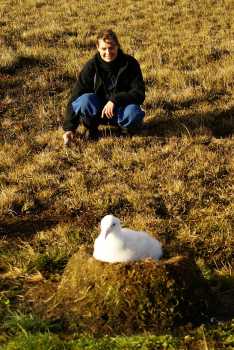What pelagic seabirds get up to at night at sea remains little known. After all, watching albatrosses and petrels during the day from ships reveals relatively few natural foraging events. So bring in the data loggers!
Sylvie Vandenabeele, a PhD student of Rory Wilson and part of the Swansea Moving Animal Research Team (SMART) at Swansea University in Wales, has this and last month been visiting South Africa's sub-Antarctic Marion Island during the annual relief to test new devices on breeding Wandering Albatrosses Diomedea exulans. The aim is to investigate their night-time foraging behaviour.
Working with Peter Ryan of the University of Cape Town's Percy FitzPatrick Institute Sylvie placed loggers on five birds brooding small chicks. The devices are known as daily diaries and record pressure, temperature, light intensity, acceleration and direction. They were back-mounted with Tesa tape, along with a separate GPS to record position. The four devices returned so far have been successfully down-loaded, but analyses must wait until Sylvie returns to Swansea.
In addition Sylvie tested a new design of harness on Wanderers at Marion, planned to be worn preened into the feathers for an extended period of time by juveniles from the time of fledging until their first return to their breeding grounds. The new harness made out of elastic material looks promising after a successful foraging trip of a few days so its deployment carrying data loggers (such as solar-powered satellite transmitters) in due course may be expected.


Sylvie Vandenabeele observes a Wanderer chick on Marion Island
Photograph by Yan Ropert-Coudert
Marion's annual relief voyage for 2012 ended on 18 May when the aging S.A. Agulhas docked in Cape Town on its last run with the South African National Antarctic Programme. Next year a brand new ship (which was in the harbour to welcome us home) will take marine ornithologists - and other researchers - "down south". I hope to be aboard.
Click here to access related papers by Sylvie Vandenabeele.
John Cooper, ACAP Information Officer, 20 May 2012, updated 29 May 2012

 Français
Français  English
English  Español
Español